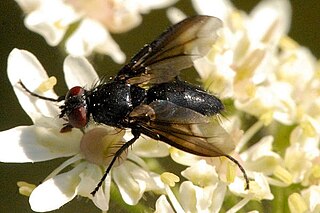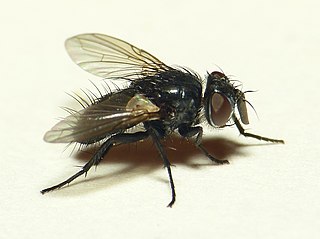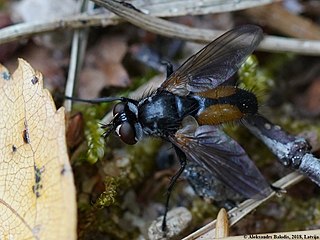
The Tachinidae are a large and variable family of true flies within the insect order Diptera, with more than 8,200 known species and many more to be discovered. Over 1,300 species have been described in North America alone. Insects in this family commonly are called tachinid flies or simply tachinids. As far as is known, they all are protelean parasitoids, or occasionally parasites, of arthropods, usually other insects. The family is known from many habitats in all zoogeographical regions and is especially diverse in South America.

Ormia is a small genus of nocturnal flies in the family Tachinidae, that are parasitoids of crickets.
Celatoria is a genus of flies in the family Tachinidae. Larvae are parasitoids of leaf beetles.

Cryptomeigenia is a genus of parasitic flies in the family Tachinidae. Larvae are parasitoids of adult scarab beetles.

Dinera is a genus of flies in the family Tachinidae. Most larvae are parasitoids of Coleoptera (Scarabaeidae).

Senostoma is a genus of parasitoid tachinid flies in the family Tachinidae. Endemic to Australasia, the flies are medium-sized, bristly, and long-legged.
Uramya is a genus of flies in the family Tachinidae.

Gymnosoma rotundatum is a parasitoid fly found in Europe and Asia.

Dexiinae is a subfamily of flies in the family Tachinidae.

Dexiini is a tribe of flies in the family Tachinidae.

Exoristinae is a subfamily of flies in the family Tachinidae. Most species are parasitoids of caterpillars.

Blondeliini is a tribe of parasitic flies in the family Tachinidae. Larvae are parasitoids of other insects, mostly beetles and caterpillars. Although nearly cosmopolitan, its greatest diversity is in the New World and especially in South America.

Goniini is a tribe of parasitic flies in the family Tachinidae. Members of Goniini are distinguished from other Tachinidae by laying small "microtype" eggs that hatch only after being ingested by a host.

Compsilura concinnata is a parasitoid native to Europe that was introduced to North America in 1906 to control the population of an exotic forest, univoltine, spongy moth named Lymantria dispar. It is an endoparasitoid of larvae and lives with its host for most of its life. Eventually the parasitoid ends up killing the host and occasionally eating it. It attacks over 200 host species, mainly insects from the Orders: Coleoptera, Lepidoptera and Hymenoptera. Since this parasite has the ability to attack many different types of hosts, the organism has spilled over from the intended forest systems into other areas, like agricultural fields, affecting cabbage pests including the cabbage looper (Trichoplusia); the cabbage worm ; and even other invasive species such as the brown-tail moth. However, it also attacks native, non-pest insects such as the Cecropia moth and American moon moth.

Hemyda vittata is a European species of fly in the family Tachinidae. It is a parasitoid of the species Troilus luridus.
Clytiomya continua is a European species of fly in the family Tachinidae. Hosts for the parasitoid larvae include Coreus marginatus orientalis, Eurygaster testudinaria, Eurydema gebleri, Eurydema dominulus, Graphosoma rubrolineatum, Homalogonia confusa, and Dolycoris baccarum. Larval development takes six to eleven days.
Uramya pristis is a species of fly in the family Tachinidae. It is a parasitoid of Limacodidae moths, and overwinters in its pupal stage.
Cyrtophloeba coquilletti is a species of fly in the family Tachinidae. It is a parasitoid of Megalopyge crispata and Epiglaea apiata moths.
Systropus macer is a species of bee flies. It is a parasitoid of Limacodidae caterpillars, including Adoneta spinuloides, Euclea delphinii, Lithacodes fasciola, Prolimacodes badia, and Parasa indetermina.
Bessa harveyi is a species of fly in the family Tachinidae. It is a parasitoid of sawflies, such as Pristiphora erichsonii.












